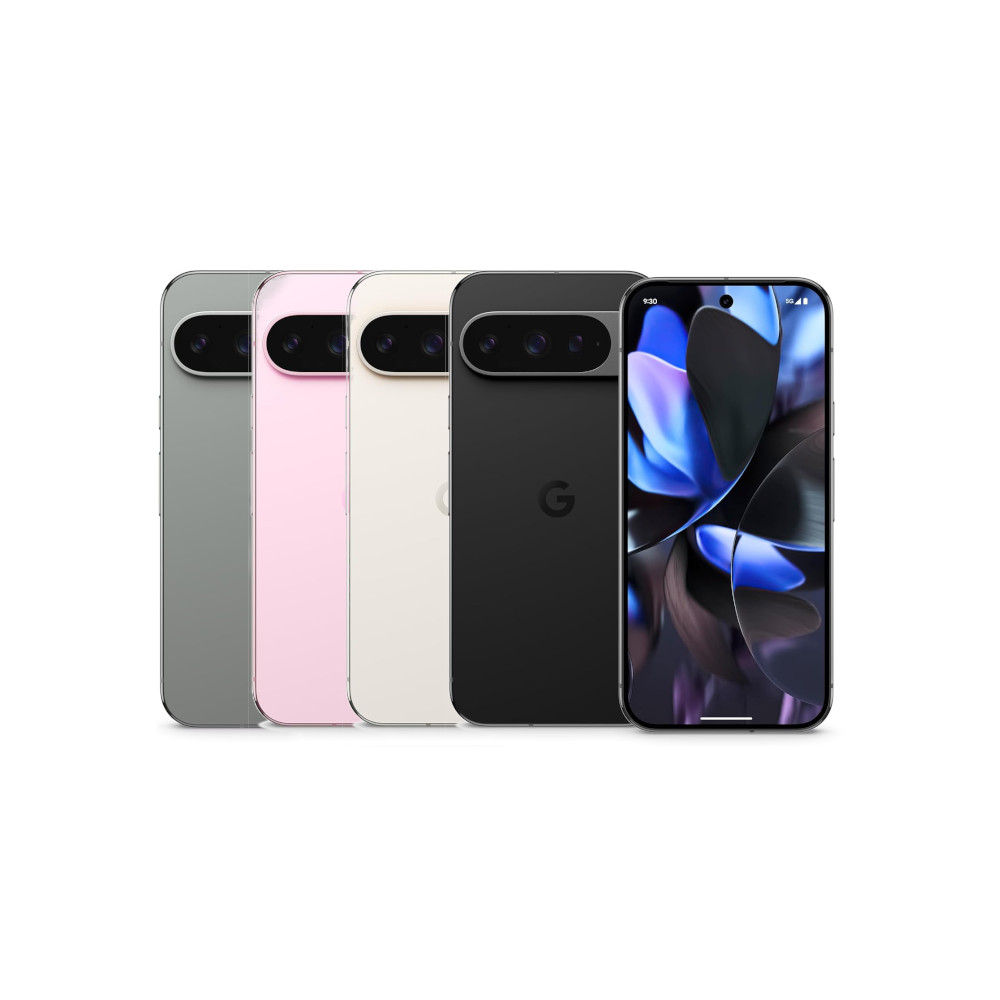Affiliate links on Android Authority may earn us a commission. Learn more.
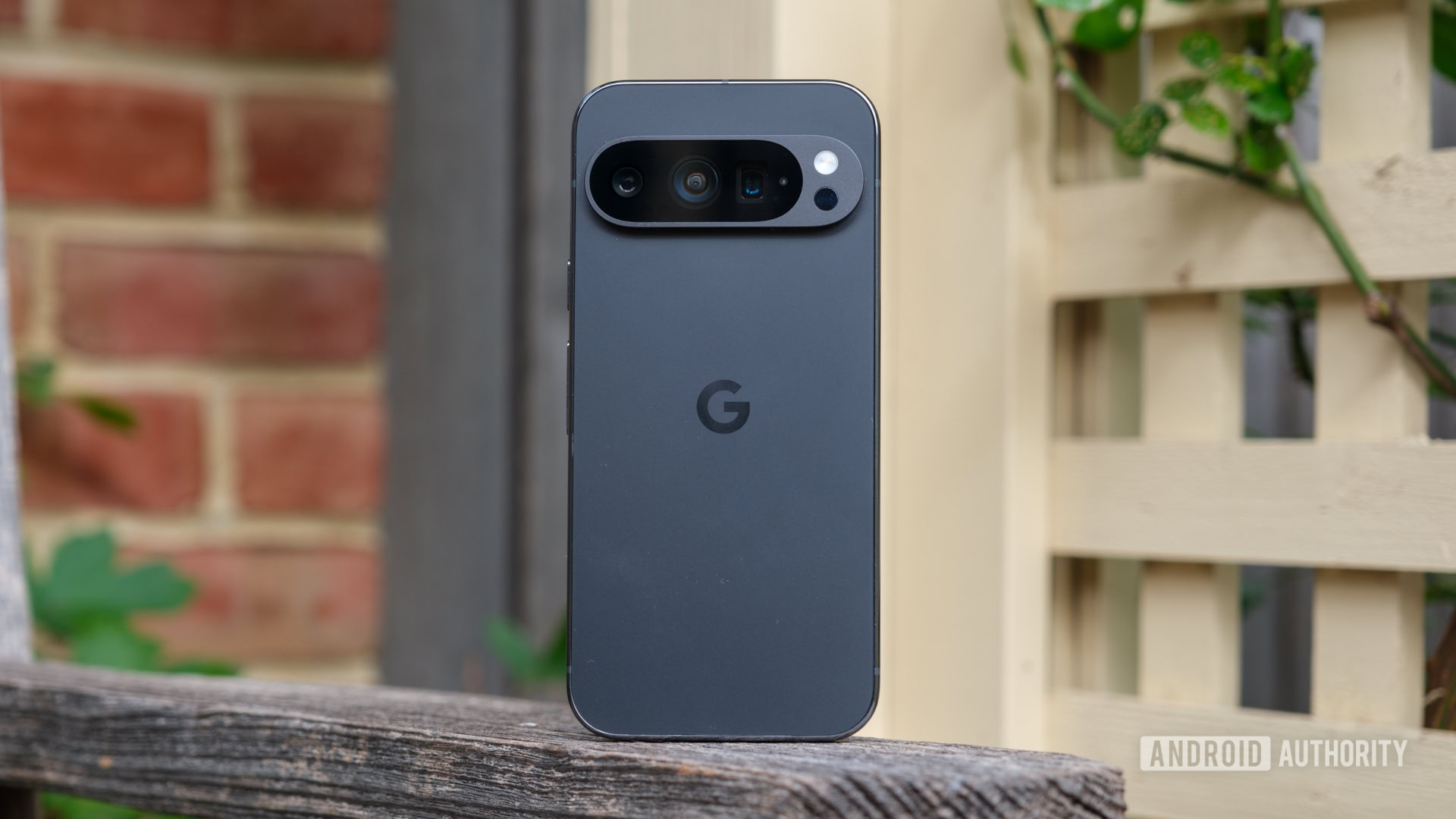

The Pixel 9 Pro is the small Android phone I've been waiting for
Published onFebruary 1, 2025

Google Pixel 9 Pro
MSRP: $999.00
What we like
What we don't like

Google Pixel 9 Pro
If you’ve read any of my many reviews here at Android Authority, you’ll know I like a small phone. You’ll know I appreciated devices like the base Pixel 8 and iPhone 15 because they would fit comfortably in my hand (and pocket) and let me go about my life without feeling like I had a tablet in my pocket.
But you’ll also know that smaller phones almost always come with compromises, like ditching a telephoto sensor, trimming a few gigabytes of RAM, or capping the charging speed — minor cuts that limit the overall experience. I always had to give something up to keep a phone I liked in my pocket, at least until Google launched the Pixel 9 Pro.
Not too big, not too small
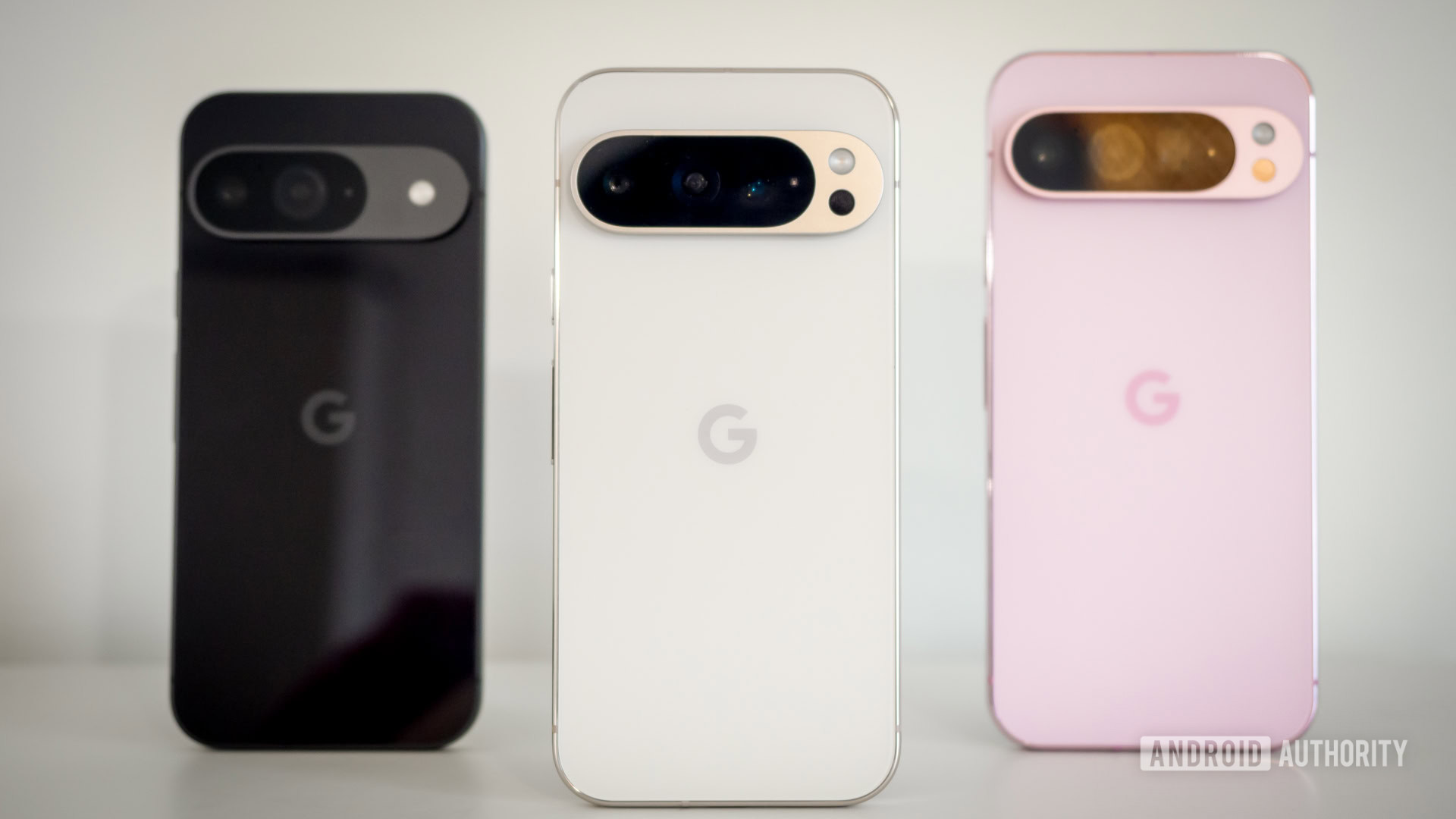
If I’ve waxed poetic once about Google’s design evolution over the years, I’ve done it a hundred times — and now I’ll do it just one more time. After all, Google’s penchant for colorful finishes and clean lines drew me to the Pixel series in the first place, and the Pixel 9 Pro is no exception. In fact, the Pixel 9 Pro specifically might well be the best iteration yet, if only because it finally gives me the top-tier Pixel experience in a phone that I can use one-handed. I think it’s fairly obvious that Google saw what Apple was doing with its two Pro-level iPhones and decided it could do one better.
That’s not much of an exaggeration, either — the Pixel 9 Pro is more iPhone-like than ever. It has a simple G logo on the back instead of a half-eaten apple and a camera bar that’s become more of an island, but the flattened side rails and display are similar enough to make Tim Cook blush. And, like I said when I called the Pixel 9 Pro XL the best iPhone ever, I mean that in the best ways. See, Apple has long set a standard when it comes to smartphone build quality. Whether or not its latest iPhone models look exciting, you know they’ll feel sturdy and reliable. Google’s annual updates, on the other hand, always felt like they had room to improve, either due to super-thin side rails, curved displays prone to accidental touches, or in-display fingerprint readers that weren’t very good.
The Pixel 9 Pro is the best-made Pixel of all time, and it even fits in my hand.
Now, it’s hard to even think of those flaws while using the Pixel 9 Pro. Google’s new 6.3-inch AMOLED panel is perfectly flat, yet the slight curve on the back of the aluminum frame allows the phone to sit comfortably in your hand for a long day of usage. Its slightly textured back panel of Gorilla Glass Victus 2 feels ever so slightly more premium than its predecessor, tucking comfortably into the glossy frame rather than sticking out behind it. And, while I thought that glossy frame might have worked against Google’s larger Pixel 9 Pro XL, it’s much easier to admire on a smaller phone that doesn’t feel like you have to hold onto it for dear life. Even if you drop it, the IP68 rating should give you a little peace of mind in dirt and water if you’re out for a weekend away from home. Nevertheless, you’ll definitely want to protect your investment with a suitable case.
Despite its smaller stature, the Pixel 9 Pro’s display packs the same impressive specs as its top-end sibling. It pairs its slim bezels with an impressive 3,000 nits of peak brightness while holding a solid 2,000 nits in high-brightness mode. Both measures are enough to keep the Pixel 9 Pro easily visible while sitting on the beach during Labor Day weekend on the East Coast — though I’ve hardly come close to maxing out the phone’s display otherwise. It’s still interrupted by a punch-hole selfie camera, but even that’s about as easy to ignore as the bezels.
I’ll admit that a small part of me, somewhere deep down, feels slightly disappointed by Google’s newfound maturity. Shrinking the camera bar and giving it durable aluminum edges might make it more durable, but it also means that the days of two-toned Pixels might be gone for good. Its side rails might be easier to hold, yet they’re less distinctive in an ever-evolving Android market. Even the color options feel more muted on the Pixel 9 series, with fun hues like Bay and Mint making way for Rose Quartz and Hazel. They’re still gorgeous, just not as fun or flashy as Pixels of the past.
However, if my biggest complaints are improved durability and slightly grown-up colors, the Pixel 9 Pro is doing many things right. Taking all the best parts of the Pixel 9 Pro XL, it’s easily the most enjoyable Pixel to use in my experience, and it feels like it should set the tone for smaller, lighter phones in the future. The Pixel 9 Pro feels like a message to Samsung, OnePlus, and other Android competitors that a pro-level phone doesn’t need a massive display.
Oh, and the temperature sensor is still here — just figured I should mention it after Google essentially forgot about it. I’m still struggling to find reasons to use it.
It still runs (mostly) like a Pro
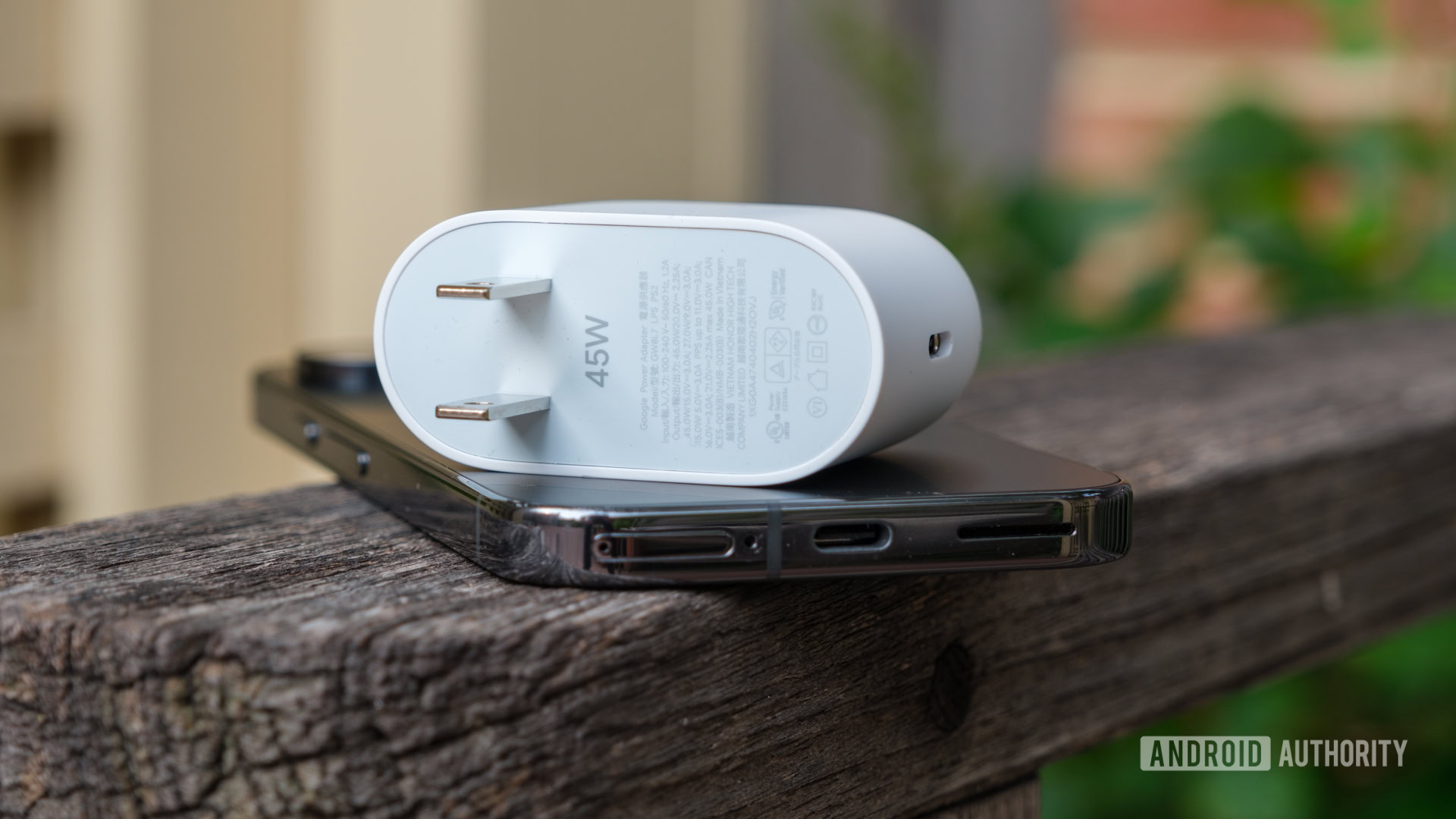
Of course, with Google packing its updated Tensor G4 chipset into a smaller body with less room for cooling components, I was a little nervous about how the Pixel 9 Pro would perform. I figured that any thermal shortcomings associated with the Tensor chip would only be amplified by its new, pocket-friendly residence and that the Pixel 9 Pro might fall a bit behind its full-sized sibling, the Pixel 9 Pro XL. I’m happy to report that I was wrong (mostly).
As usual, I put the chipset — which comes backed by 16GB of RAM and a disappointing 128GB of storage in its base configuration — through its paces with our usual set of CPU, GPU, and battery tests. But, while you might expect that extra RAM to kick things up a notch, you can only actually use 13GB of it with the remaining 3GB carved out for Gemini. Anyway, I lined it up against its top Android foes and Apple’s more portable Pro, if only so that it could tell me what I already knew: The Tensor G4 is still no benchmarking beast.
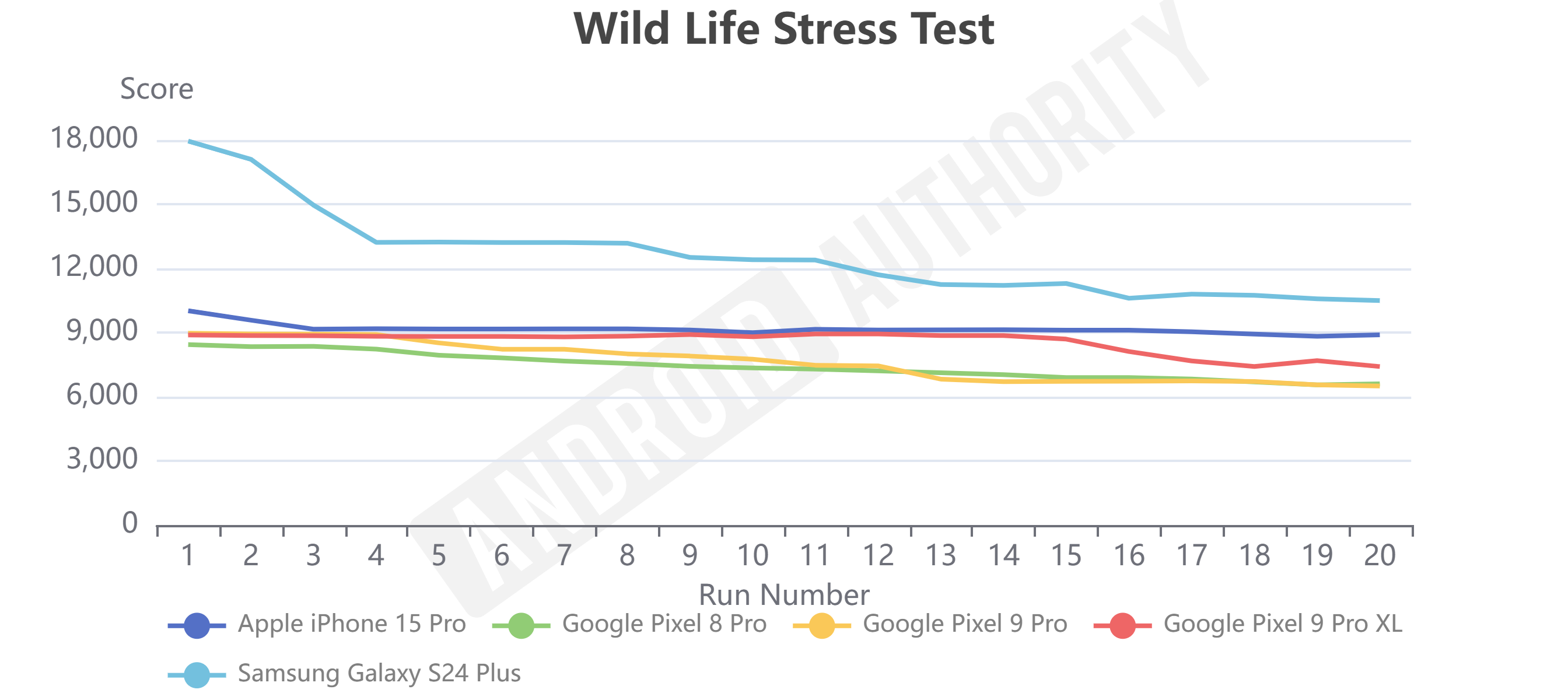
Sure, it beat its predecessor, the Tensor G3, in just about all of our testing, but it still has a decent gap to make up before it’s genuinely racing against the Qualcomm Snapdragon 8 Gen 3 or Apple’s A17 Pro — though rumor has it that we might see some of those improvements on the Pixel 10. Surprisingly, the Pixel 9 Pro is neck and neck with the larger Pixel 9 Pro XL across most of our workload and CPU tests. It’s not a significant gap — just a percentage point or two across most of my tests — but good news for small phone enthusiasts everywhere. That said, the expected dip in GPU performance for the smaller Pixel 9 Pro is pretty visible as the phone drops to the Tensor G3-powered Pixel 8 Pro‘s performance after just five runs, while the XL version manages to sustain decent stability for another 10 runs. This is likely due to the reduced room for the new vapor chamber.
Of course, while we compared the Pixel 9 Pro to the latest from Apple and Google at its launch, things have changed since then. The iPhone 16 series arrived with Apple’s A18 chip under the hood and Samsung’s Galaxy S25 series picked up an overclocked Snapdragon 8 Elite for Galaxy processor, both of which open the gap a little bit wider over the Tensor G4. So, we’re right back to Google feeling a bit further behind on paper, but we’ll hold out some hope for the next generation to tighten up again.
The Pixel 9 Pro's performance keeps up with the XL model... mostly.
Thankfully, the Pixel 9 Pro feels just as capable as its sibling in day-to-day use. I headed down to the Jersey shore for a holiday weekend and compared my Pixel 9 Pro head-to-head against the Pixel 9 Pro XL my dad recently bought from Verizon. We started our days at about the same time, me kicking off my day with a mix of Spotify streaming and checking the Chelsea FC score a few times throughout a five-mile run and him heading to the end of the island to capture some photos and see how the cameras compared to the Galaxy S21 Ultra that he traded in.
The rest of the day saw us use our Pixels a bit closer together, sitting in the sun and sand and putting the Tensor G4 under a bit more thermal load than it probably would have liked. I put my Pixel 9 Pro through an hour or so of gaming, split between Royal Match and Warhammer 40,000: Tacticus, which warmed it up a bit, but never to the point where I needed to hide it in the shade to let it cool off. Even though my stretch of gaming didn’t cook the Tensor G4, it did show me one thing — the Pixel 9 Pro has a bit of a battery weakness.
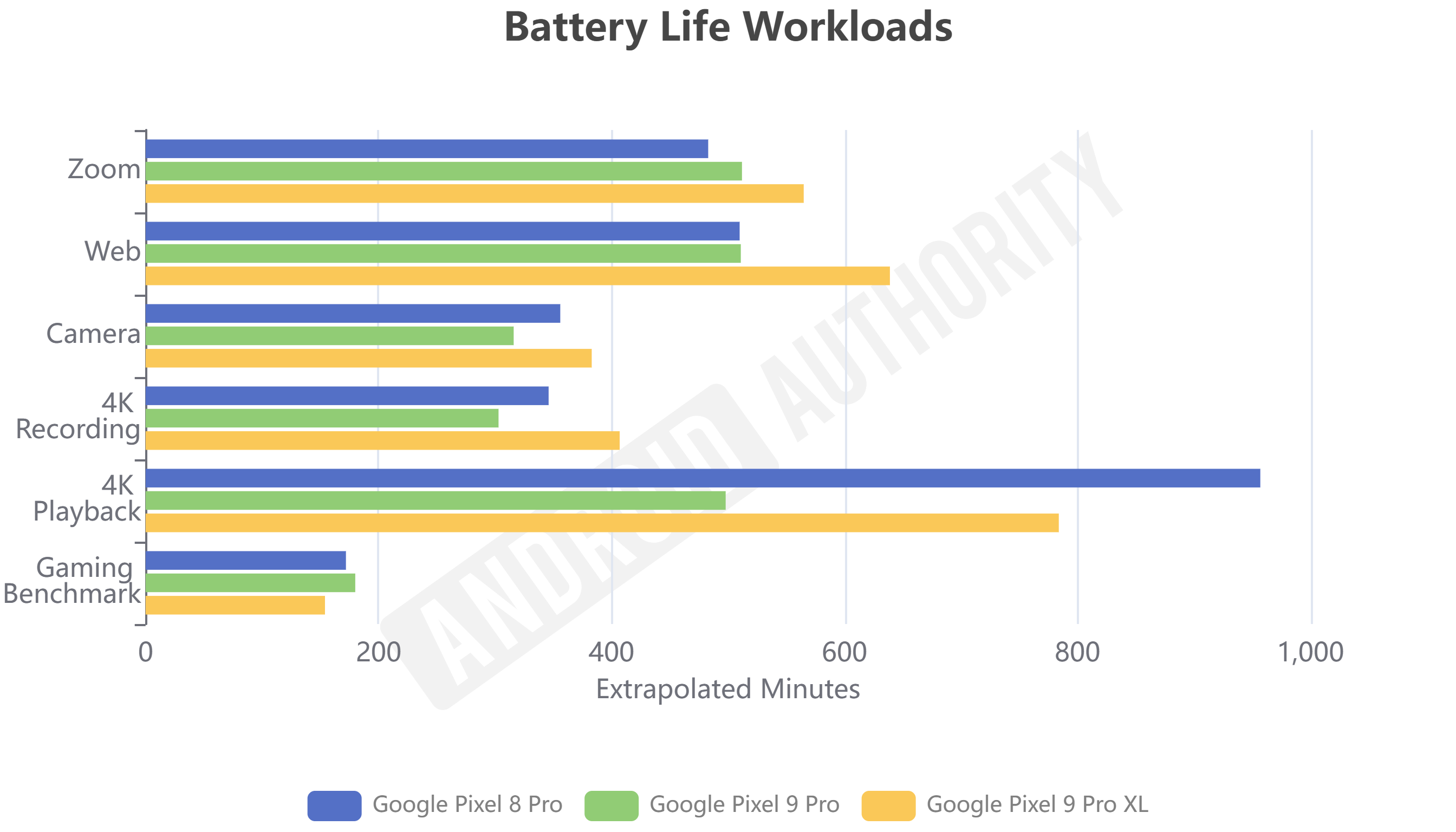
I know what you’re thinking — of course, the Pixel 9 Pro puts in a shorter battery shift than Google’s other Pro-grade Pixels; it has a smaller battery (over ~300mAh smaller than the XL). That’s true, but it’s also powering a smaller display, so I was still surprised to see such a gap in our battery drain testing. It fell short of the Pixel 9 Pro XL by a pretty good margin across all categories, faring the worst when 4K video was involved — either recording or playback.
The smaller Pixel’s Zoom and web results are a bit more respectable, and it leads Google’s trio in gaming durability, but it’s not enough that you can expect two full days of usage between charges. Real life involves a better mix of usage, so you might not feel the effects of poor gaming battery usage, but I found myself reaching for a charger more than every 36 hours.
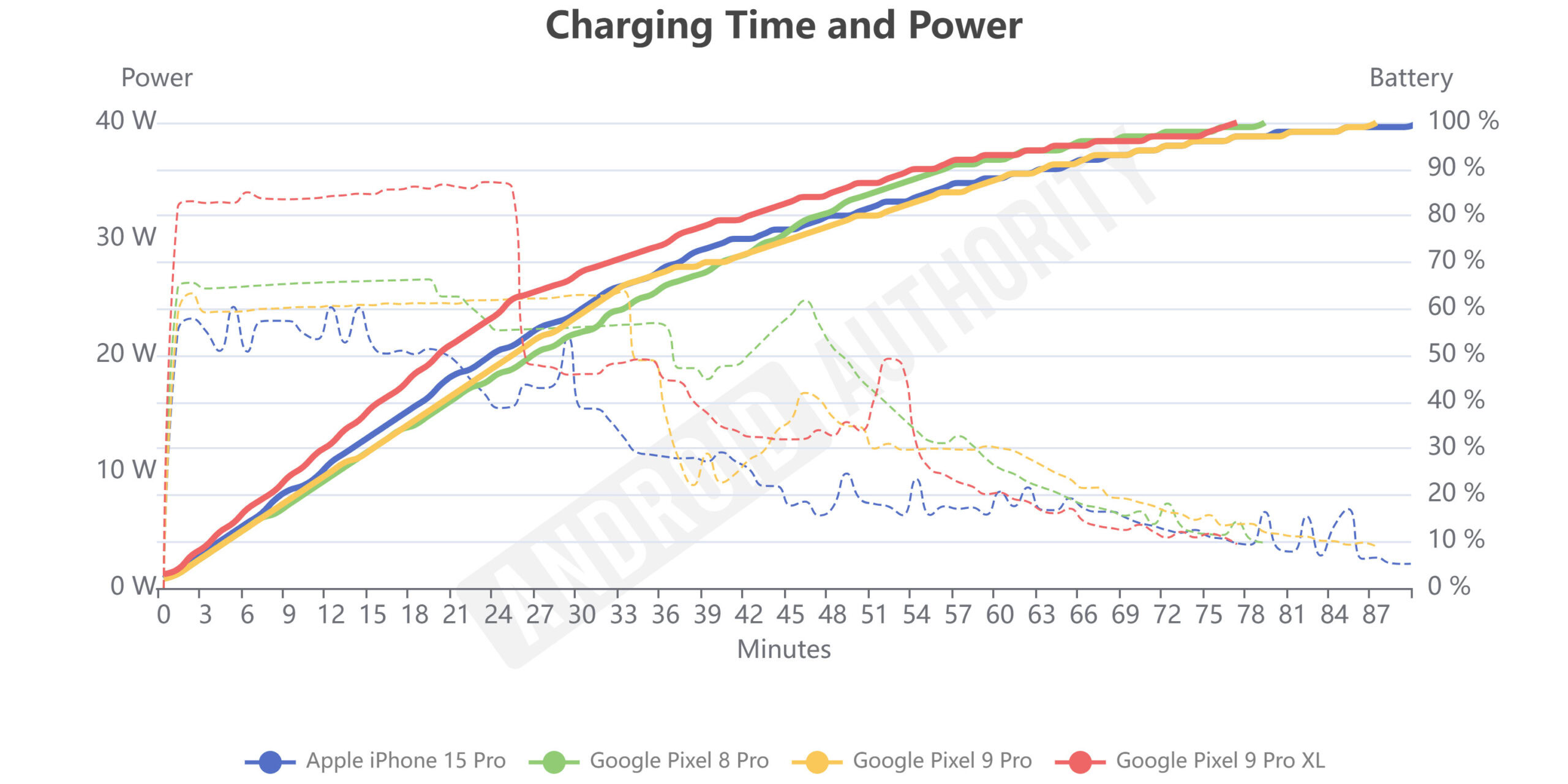
When you need a charge, you’ll run into another one of Google’s puzzling Pixel decisions. Even though it bumped the Pixel 9 Pro XL’s wired charging up to 37W, it left the Pixel 9 Pro behind with 27W wired charging with a USB PD PPS-enabled charger. Strangely, that’s the same speed the previous Pixel 8 Pro supported, but you wouldn’t know it from the graph above. The Pixel 9 Pro took almost 90 minutes to fill with Google’s brand-new 45W charger, while the Pixel 8 Pro filled its larger battery nearly 10 minutes quicker with an older 68W Motorola TurboPower charger I had lying around.
Interestingly, our testing showed that the Pixel 9 Pro spent more time charging at near-peak speeds (21 minutes instead of 19), but it reached a top temperature of 42.2 degrees Celsius compared to the Pixel 8 Pro’s 38.2 degrees, which is likely where you see the dropoff at around the 35-minute mark above. Thankfully, though, the Pixel 9 Pro appears capable of reaching its full 27W speeds from that same TurboPower charger that I’ve trusted for a few years — unlike the Pixel 9 Pro XL, which seems to require an extra special set of chargers to reach its full potential due to weird interactions with charger voltage.
You can also skip Google’s headache of a wired setup and charge your Pixel 9 Pro wirelessly, in which case it’ll reach 21W with the second-generation Pixel Stand ($79 at Best Buy) or 12W from any other Qi-certified pad. I wish I could make complete sense of Google’s plan for its charging setup, but alas, Goog’ gonna Goog’.
Portable Pixel cameras
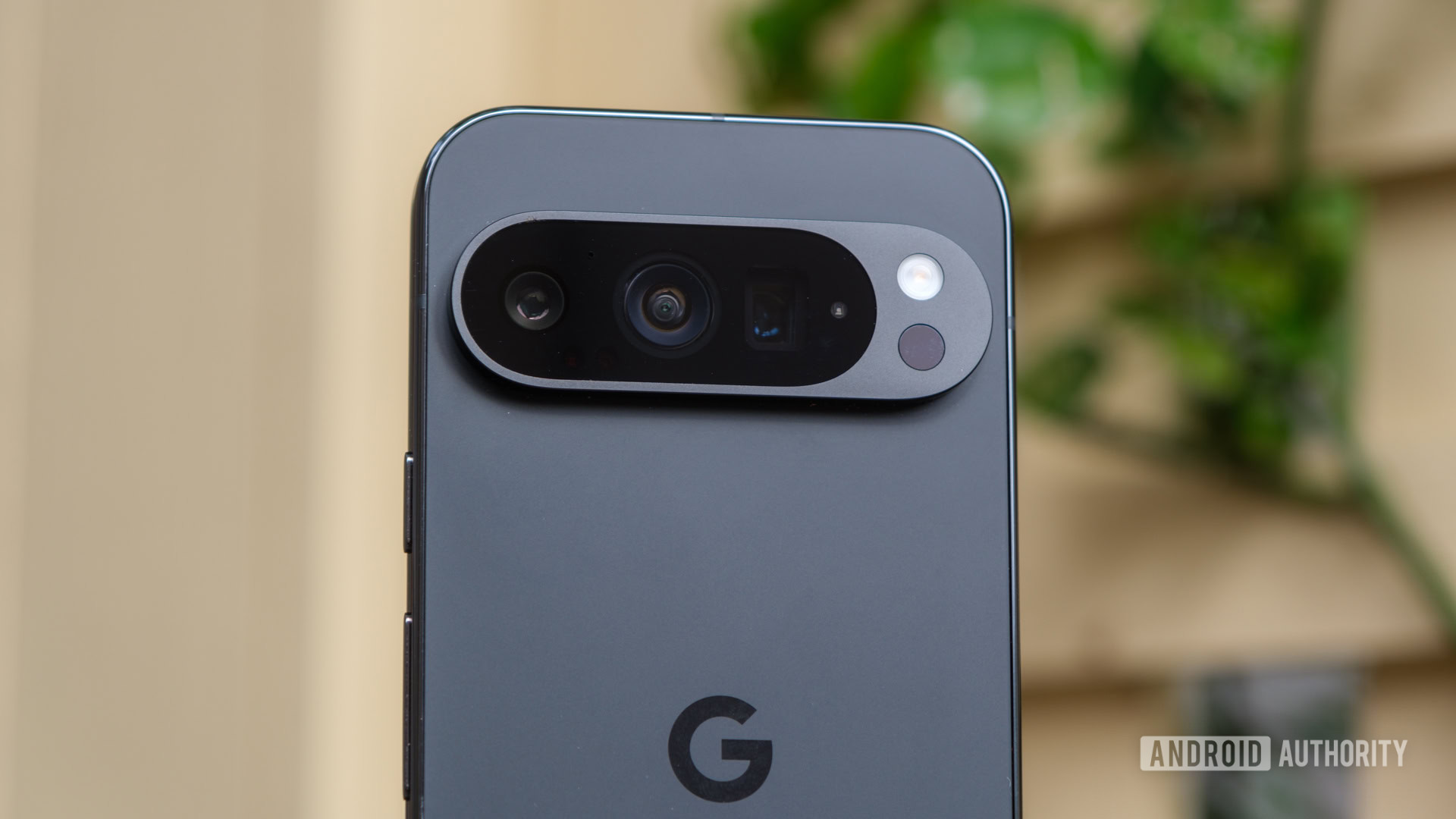
One thing I wasn’t worried about was Google’s cameras not living up to the hype on the Pixel 9 Pro. After all, it packs the same trio of high-resolution sensors I just finished testing on the Pixel 9 Pro XL, just in an easier-to-wield form factor. That means you once again have a 50MP primary sensor with a shallow maximum aperture of ƒ/1.7 with which to capture your world, as well as ultrawide and telephoto sensors to back it up. They fill out the camera bar nicely and make the Pixel 9 Pro one of the best camera phones around — especially at its size.
Both of Google’s peripheral lenses offer matching 48MP resolutions but are pretty much opposites otherwise. The ultrawide snapper gained the same maximum aperture as the primary camera but swapped to a slightly tighter 123-degree field of view — just like the Pixel 9 Pro XL. While you probably won’t notice that loss of three degrees, you’ll probably welcome the extra light capture, which should make it easier to grab macro shots using Google’s software-based solution. Oh, and it’s a little easier to get close to your subject with the smaller 6.3-inch footprint. The Pixel 9 Pro’s periscope telephoto sensor offers less of a change from its predecessor, sticking with 5x optical zoom and reaching up to 30x Super Res Zoom. Let’s head to the beach to check out a few camera samples.
First, proof that Google still knows how to shoot and process a well-lit photo. My weekend at the beach wasn’t quite as adventurous or colorful as my trips to Pittsburgh and Washington, DC, with the Pixel 9 Pro XL, but I found that the smaller Pixel 9 Pro was just as willing to pull details out of shots throughout its zoom range. I’m particularly pleased with the photo of the sun setting over the bay, which caught everything from the color of the sky to the small birds on the dock and kept the wood boards in the foreground in soft focus.
The image of the capybara in the second row is good, too, even if the water around the world’s largest rodent is pretty gross. Google nailed the colors of the floating leaves and the shade as it falls across the animal’s fur, and you can just about make out the turtle swimming just below the surface of the background. I would have liked a little more pop in the image of the boats next to it, though, which looks a little bit dead and flat.
Thankfully, I got all the pop I wanted on an evening walk downtown. The Pixel 9 Pro gave the middle image of a neon sign plenty of glow in the building and on the tree in the background while preserving the barely visible telephone wires overhead. I’m impressed that you can still make out a bit of green in the leaves in the shot to the left, too — low-light photos often crush those clusters to blackness.
I’ve said this before, too — macro mode should always be software-based, and the Pixel 9 Pro shows why. It gives its 48MP ultrawide sensor double duty, and the wide-open aperture means that it can grab more light to process. The result is a snail shell that shows every last grain of sand and a Black-Eyed Susan with plenty of detail through its “black eye.”
Google’s overall zoom range is pretty impressive, too. I would typically bin almost all of my 10x and 30x samples shortly after writing a review, but I’m pleased with the details in the seagull and the tracks in the sand at 10x zoom. Our feathered friend is a little bit fuzzier at 30x zoom, but you can still make out that he’d come to steal your hotdog if given a chance.
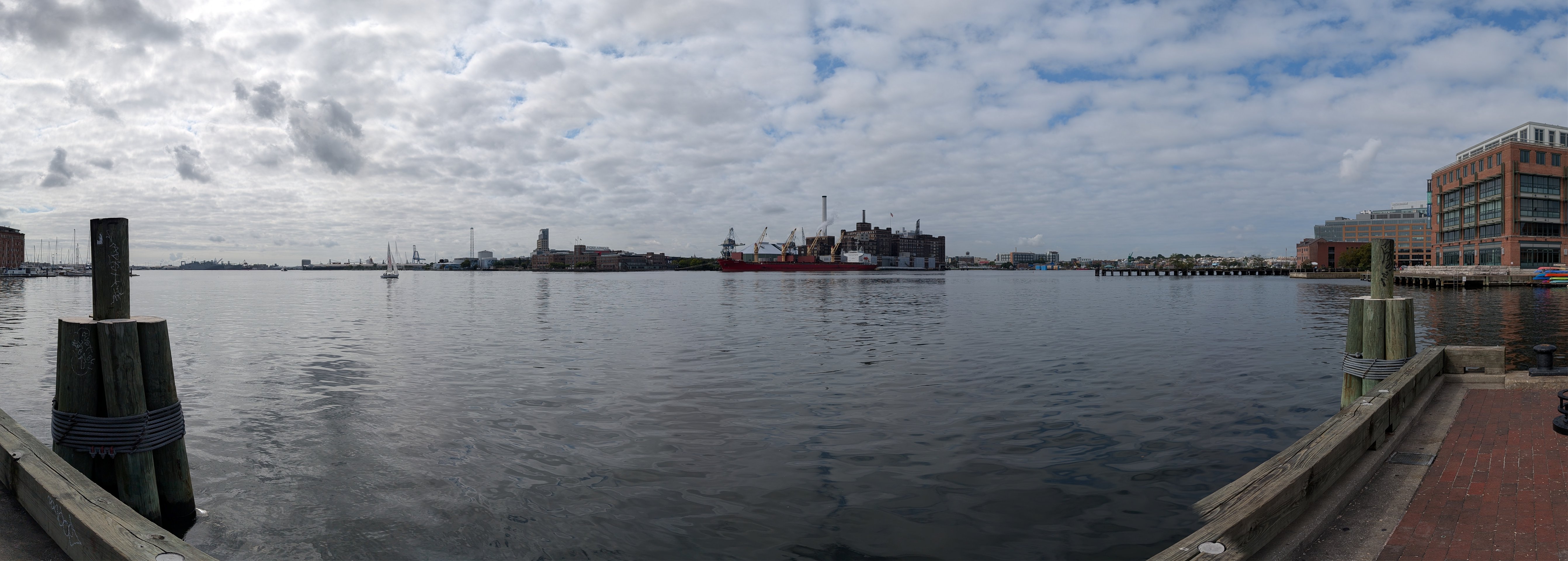
And then, there’s Google’s updated selection of AI-powered features. I already mentioned that I liked the revamp of panorama mode on the Pixel 9 Pro XL, and it’s just as good here. It’s incredibly simple to line up your shot across a series of dots rather than trusting a steady hand, even if there’s a tiny processing error along the dock to the right side.
Unfortunately, Zoom Enhance isn’t quite as impressive. It took almost a year to launch after being announced alongside the Pixel 8 Pro, but the result is a photo that looks far too sharp in some places while not looking much different in others. The patriotic badge to the right seems almost like it’s been cut with a laser to capture the leaves and outline, giving it edges that are much too sharp. Rather than Zoom Enhance, the feature feels more like Zoom Oversharpen, and sharper isn’t always better.
Zoom Enhance? More like Zoom Oversharpen... which isn't the same thing.
Other AI-powered features let you be a little more creative, like the improved Reimagine option in Magic Editor. On top of resizing and rearranging elements of your shot, you can now replace the sky, the ground, and things your subject is holding with a tap and a little typing. The Pixel 9 Pro still gets a little fuzzy at the edges of its image generation, but it’s significantly better than the artifact-heavy version launched with the previous generation.
Google gave the Pixel 9 Pro the same selfie camera overhaul as the Pixel 9 Pro XL, which remains one of the bigger surprises in this year’s camera setup. It packed a 42MP sensor into its punch hole, which captured more accurate colors and details when I compared it to the base Pixel 9’s 10.5MP shooter.
I could copy and paste the Pixel 9 Pro’s video chops if I wanted to, too — they’re the same as the Pixel 9 Pro XL. It can shoot clips at up to 20x Super Res Zoom, which Google will then apply Video Boost for smoother, sharper final results. The Pixel 9 Pro can upscale videos to 8K resolution, from which you can clip 33MP stills.
You can also check out full-resolution versions of these samples (and several more) at this Google Drive link. Oh, and if you want even more samples from the Pixel 9 Pro XL — which has the same hardware — we have a gallery of those at this Google Drive link.
And, of course, there’s Gemini
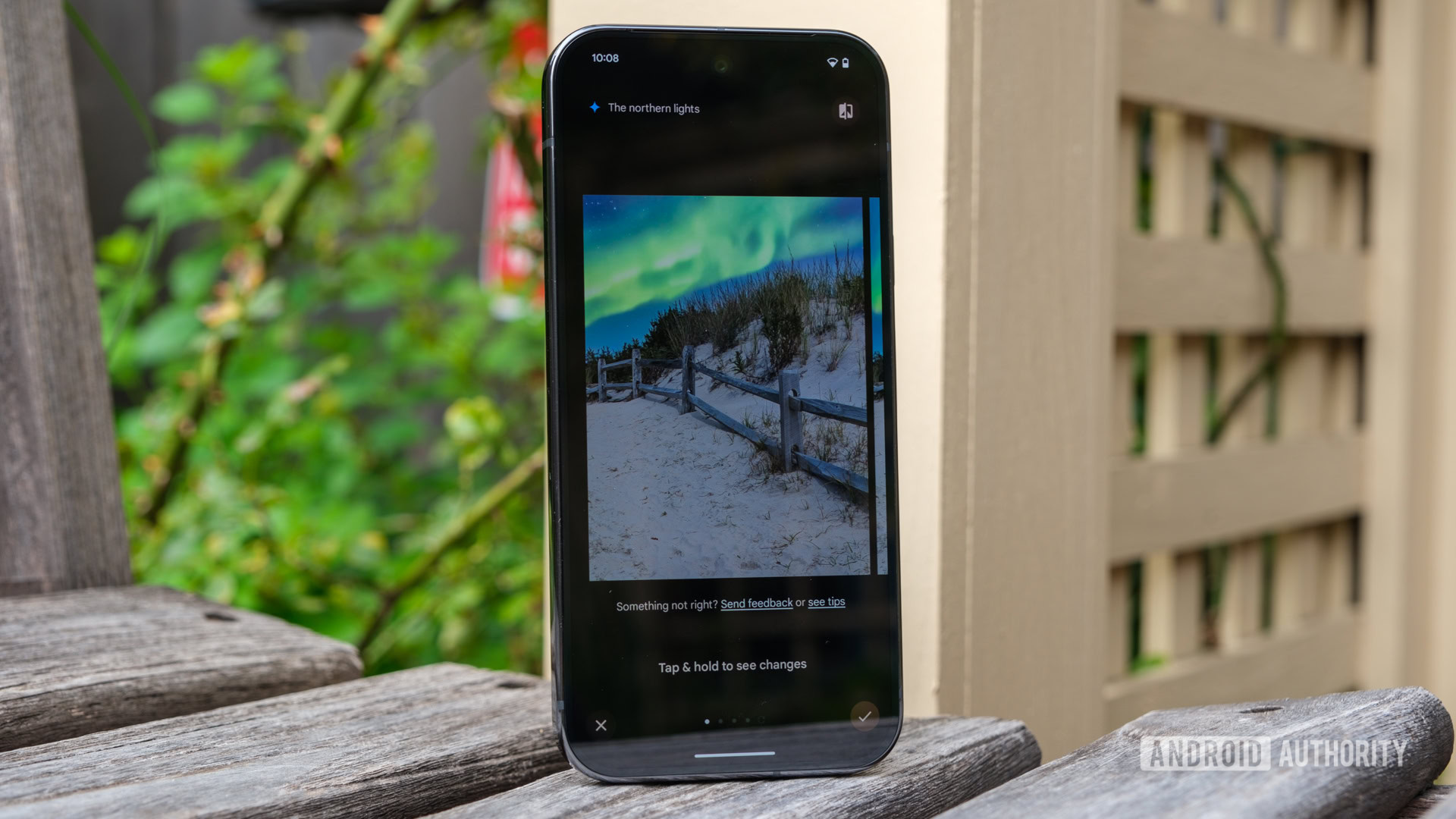
As you’ve probably figured out, everything the Pixel 9 Pro XL can do, the Pixel 9 Pro can do too — just smaller. That, of course, includes its mountain of AI-powered capabilities. I’ve already touched on a few camera-focused features above, but they’re only the start of Google’s lofty plans for the Gemini age.
And yes, I still have reservations about everything I do being used to train Gemini (one week in Pixel-land isn’t enough to change that), but Google’s finished product is much better than the current offerings from Samsung, Motorola, and other phone brands hurriedly jumping into the AI race. Maybe it rushed a few things to market on the Pixel 8 series and launched its Gemini Assistant without giving it the power to, well, assist with your smart home, but it’s clear that Google has learned a lot in the last year or so.
Gemini has come an impressively long way in just one generation, whether I'm creating images or asking tricky questions.
Everything feels a little smoother and quicker, whether you’re chatting with a revamped and interruptible Gemini Live or generating images from text in Pixel Studio. I’ll admit that since swapping from the Pixel 9 Pro XL to the Pixel 9 Pro, I’ve been a bit more inclined to use the latter than the former — but that’s more so I wouldn’t have to explain the concept of Gemini Live to my grandparents while sharing a beach house for the weekend. The fact still stands that Gemini Live, with its eight interchangeable voices, is scary good, just in a way that I think would freak out two people who currently use a Motorola Moto G Play from 2021.
On the other hand, Pixel Studio feels like something every parent wishes they had when their kid asked them to draw something. In fact, that’s kind of how I explained it while showing off my “smartphone of the week,” as my family calls it. This time, I stuck to a theme of beach-related creations, putting animals on surfboards and burying treasure on 85th Street, and the Pixel Studio continued to show off its Imagen 3-powered chops. You still can’t generate people, though, making the overall experience much different from Samsung’s Portrait Studio.
Other features, like the revamped Pixel Weather app and all-new Pixel Screenshots app, are more like the unsung heroes of Google’s Gemini revolution. You might not notice things like organizable widgets for the air pressure and wind direction if you never scroll past the hourly forecast and radar, but the AI-generated Weather Report is like the one-sentence reminder your mom used to give you before you headed out the door for school in the morning. I’ll also readily admit that I’m not a screenshot guy — preferring to leave a billion Chrome tabs open as reminders — but I might start changing my tune if I can remember to make folders every time I research seven vs seven soccer tactics and look for betting advice during college football season.
These are also just the Gemini features we can use so far. Google’s Pixel 9 series is promised software updates for seven years, including Pixel Drops, including security patches, Android versions, and regular feature drops. The Pixel 9 Pro launched with Android 14, which seemed like an unusual step, but it picked up Android 15 shortly after launch.
Google Pixel 9 Pro review verdict: Small and mighty in equal measure
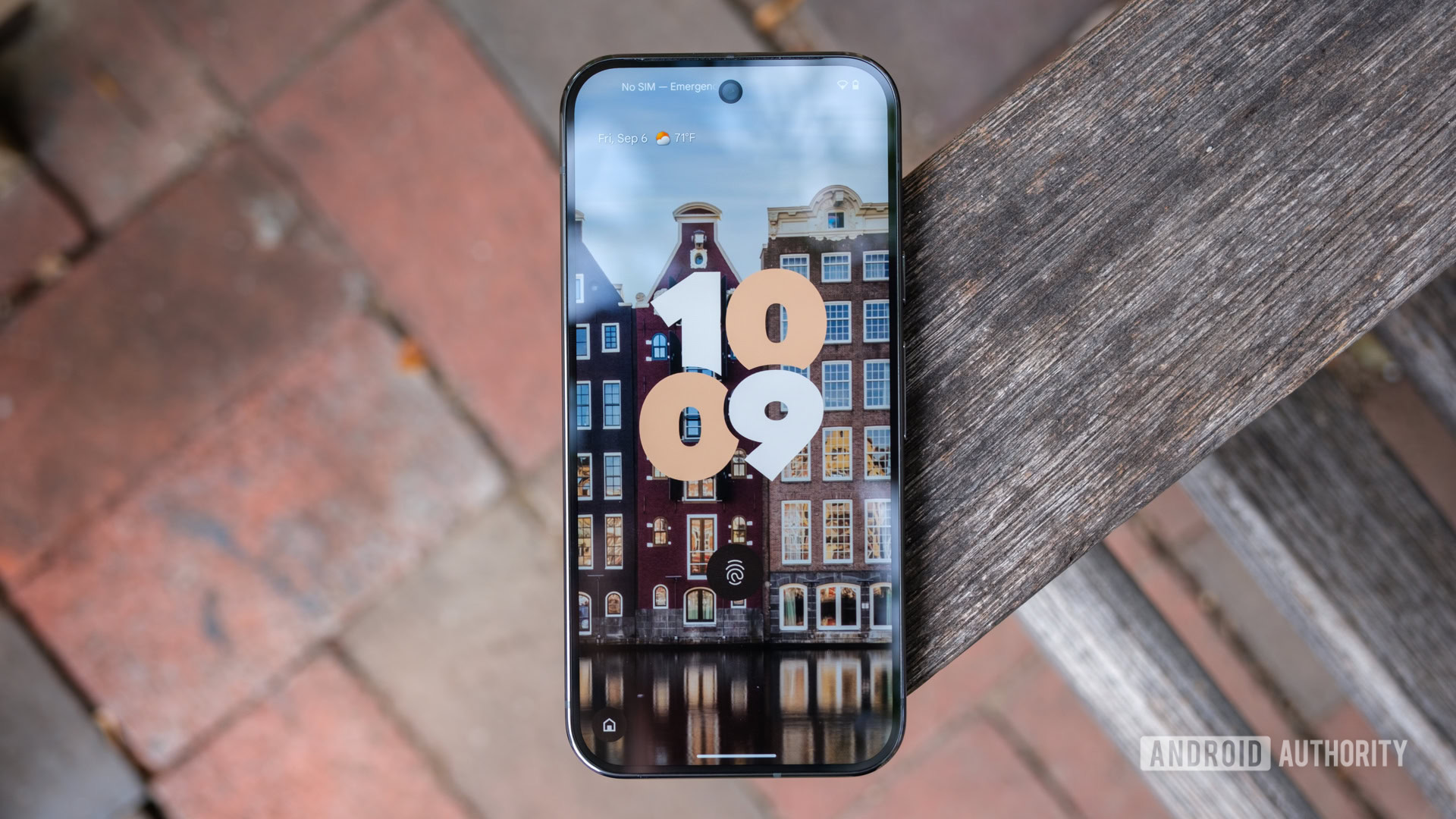
When I finished reviewing the Pixel 9 Pro XL, I called it the phone I’d been waiting for. As it turns out, the Pixel 9 Pro was the phone I actually had been waiting for — I just didn’t know it. Everything I said about Google’s larger flagship absolutely still rings true, with impressive cameras, an impressive suite of AI-powered features that are mostly user-ready, and a build quality that’s head and shoulders above Pixels of the past. The Pixel 9 Pro XL is a sublime choice for anyone who wants the very best Pixel has ever had to offer and wants it in the biggest package possible. But for me, it’s just far more enjoyable on a phone that I can use with one hand.
Google’s ability to pack this much power into a 6.3-inch smartphone should put other Android flagship series’ on notice. You don’t need to churn out a nearly 7-inch smartphone to call it a Pro or even an Ultra (though I guess that size still justifies the Plus moniker). The Pixel 9 Pro combines a battery capacity that rivals the Galaxy S24 Plus, cameras that out-process the OnePlus 12, and an update commitment that goes up against just about anyone. Factor in its build quality, and there aren’t many phones I’d reach for before this one.
Finally, a pro-grade Pixel that fits comfortably in my pocket.
And yet, the Pixel 9 Pro isn’t without a few small phone compromises. Google didn’t see fit to bring its fastest charging to its smaller model, nor has it figured out a few of the kinks (thermals and benchmarking) that have plagued the Tensor chip since its earliest days. Perhaps the latter results from the former, but we’ll probably find out when Google makes its anticipated switch from Samsung to TSMC for its next in-house chipset. I don’t think either flaw is a true dealbreaker, though, as the Pixel 9 Pro escapes most of the charging headache that plagues its big brother while feeling just as smooth as any other flagship from day to day.
But if you want a solution for at least one of those issues, Google has a Pixel 9 Pro XL ($1099 at Amazon) that it’ll sell you. It offers almost the same experience as the Pixel 9 Pro, from the flattened-out design to the brilliant cameras and Gemini infusion, just bigger. It picks up an extra half-inch of screen real estate to match its 5,060mAh battery and grabs the 37W wired charging that can save you a few minutes — provided you have one of a particular set of chargers. My colleagues and I don’t often hand out five-star ratings at the end of reviews, but the Pixel 9 Pro XL more than earned its accolades.
Should you decide to venture outside of Google’s ecosystem, it becomes a bit tougher to choose natural rivals for the Pixel 9 Pro. It’s configured closer to Samsung’s Galaxy S25 Plus ($999.99 at Amazon), yet sized to match the base Galaxy S25 ($809.99 at Amazon). Personally, I’d rather have Google’s more natural cameras and more complete AI experience, but I’m sure that some will reach for the Galaxy S25 Plus with its larger 6.7-inch display and faster 45W wired charging at the same price. Both of Samsung’s smaller phones pack the more powerful Snapdragon 8 Elite for Galaxy chipset, which might sway users, too, even though it won’t feel any quicker in day-to-day usage.
And then there’s the iPhone — Google’s twin from another operating system. Whereas the Pixel 9 Pro XL matched up nicely against the iPhone 16 Pro Max, the Pixel 9 Pro is more comfortable against the smaller iPhone 16 Pro ($999 at Amazon). From the side, the two are nearly twins, sharing flat frames and glossy finishes and even matching the placement of their antennas with only the square camera bump and Google’s camera bar to tell them apart, as well as Apple’s new Camera Control, which I’ve only found a few reliable uses for. Of course, going for the iPhone probably means diving headfirst into Apple’s larger ecosystem, which could be quite the investment once you add an Apple Watch and maybe an iPad to replace your current Android alternatives.
